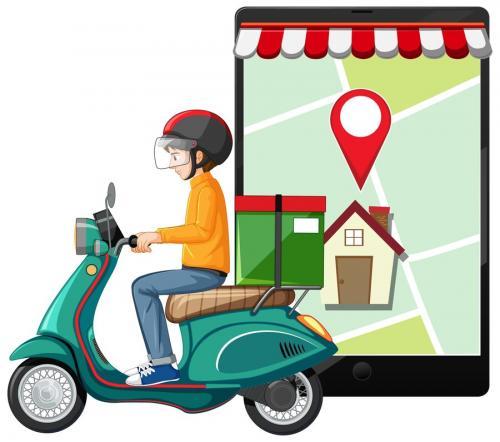Challenges and Opportunities for Restaurants in the App Age

The rise of food delivery apps has undeniably transformed the restaurant industry. These mobile applications have become ubiquitous, offering convenient on-demand food delivery to consumers and significantly impacting how restaurants operate and reach their customer base. However, the influence of food delivery apps is a double-edged sword, presenting both significant challenges and exciting opportunities for restaurants in the app age. Challenges: Navigating the New Landscape
While food delivery apps offer a plethora of benefits, there are also challenges that restaurants need to consider:
Commission Fees: A major challenge for restaurants is the commission fees charged by third-party delivery platforms. These fees, typically a percentage of each order processed through the platform, can eat into a restaurant's profit margin. Restaurants need to carefully evaluate the potential increase in sales generated by partnering with a delivery service against the cost of those commissions. It's crucial to choose platforms with reasonable commission structures that align with the restaurant's overall business goals.
Maintaining Food Quality: Ensuring food arrives hot, fresh, and well-presented during delivery can be a challenge. Factors like travel time, weather conditions, and proper packaging all play a role in maintaining food quality. Restaurants can mitigate this challenge by investing in high-quality packaging solutions that insulate hot items, prevent leaks, and maintain the integrity of delicate dishes like salads or pastries. Additionally, maintaining clear communication with delivery partners regarding proper food handling practices is essential.
Limited Control over Customer Experience: Reliance on third-party delivery platforms for order fulfillment and customer service can limit a restaurant's control over the overall customer experience. Negative experiences with delivery drivers, such as long wait times or mishandled orders, can reflect poorly on the restaurant despite the food itself being of high quality. While restaurants may have limited control over the delivery process itself, they can take steps to mitigate the impact on customer experience. This could involve including clear instructions for delivery drivers within the app or offering customer support options that allow diners to directly contact the restaurant in case of any issues.
Opportunities: Embracing the Power of Food Delivery Apps
Despite the challenges, food delivery apps present a wealth of opportunities for restaurants to thrive in the app age:
Increased Reach and Customer Base: Food delivery apps allow restaurants to expand their reach beyond the limitations of their physical location. Customers located outside a restaurant's immediate vicinity can now easily discover and order food online, significantly increasing the potential customer base. This can lead to increased sales and revenue for restaurants, particularly those situated in areas with less foot traffic.
Data-Driven Insights: Many delivery platforms provide restaurants with valuable data and customer insights based on ordering trends within the app. This data can be a goldmine of information, allowing restaurants to:
Optimize Menus: Analyze data to identify popular dishes and customer preferences. This information can be used to inform menu development by introducing new items that cater to specific dietary needs or trending tastes, potentially increasing sales and customer satisfaction.
Targeted Marketing Campaigns: Leverage customer data to develop targeted marketing campaigns based on demographics and ordering habits. Restaurants can reach new customers and retain existing ones by offering promotions or discounts that appeal to their specific preferences. Understanding which items are most popular for delivery can also inform targeted promotions and special offers specifically for delivery orders.
Evolving Menus and Offerings: The ability to cater to a wider audience and changing consumer preferences can influence menu development. Delivery-friendly options that travel well and maintain their quality during transport may become more prominent. Additionally, the ability to reach a broader customer base can encourage restaurants to experiment with new cuisines or cater to specific dietary needs, such as vegan or gluten-free options. This can expand their offerings and attract new customer segments.
Marketing and Promotions: Delivery apps offer new avenues for restaurants to reach a wider customer base through targeted marketing campaigns and promotions. Many platforms allow restaurants to offer special discounts or deals specifically for delivery orders, making their offerings more competitive and attracting new customers who might be price-sensitive. Highlighting unique selling points and offering attractive promotions can entice users to choose a particular restaurant within the app.
Custom Food Delivery App Development: For restaurants seeking greater control over branding, user experience, and potentially eliminating commission fees, developing a custom food delivery app can be a strategic option. This allows for:
- Complete Brand Control: Maintain complete control over the app's design, branding, and user experience to ensure it aligns perfectly with your restaurant's image and overall customer experience strategy. This allows for a more seamless and personalized experience for your customers.
The rise of food delivery apps has fundamentally reshaped the restaurant industry, presenting both challenges and opportunities. Restaurants that understand these dynamics and adapt their strategies accordingly are well-positioned to thrive in the app age.
By carefully evaluating commission fees, prioritizing food quality, and mitigating limitations on the customer experience, restaurants can navigate the challenges associated with third-party delivery platforms. Embracing the opportunities presented by these apps, including increased reach, valuable customer data, and the potential for menu innovation, allows restaurants to expand their customer base, optimize their offerings, and potentially increase revenue.
Post Your Ad Here
Comments